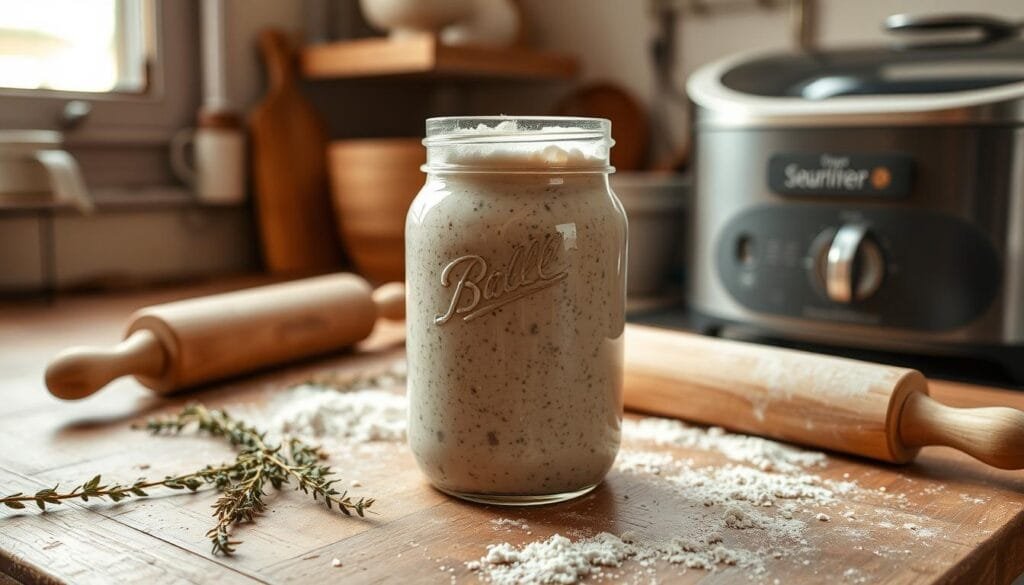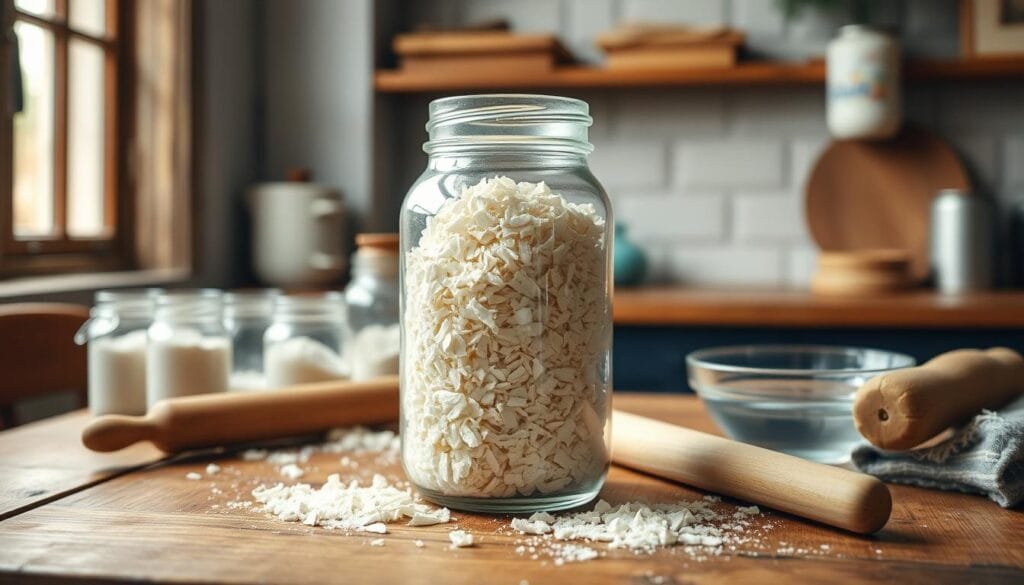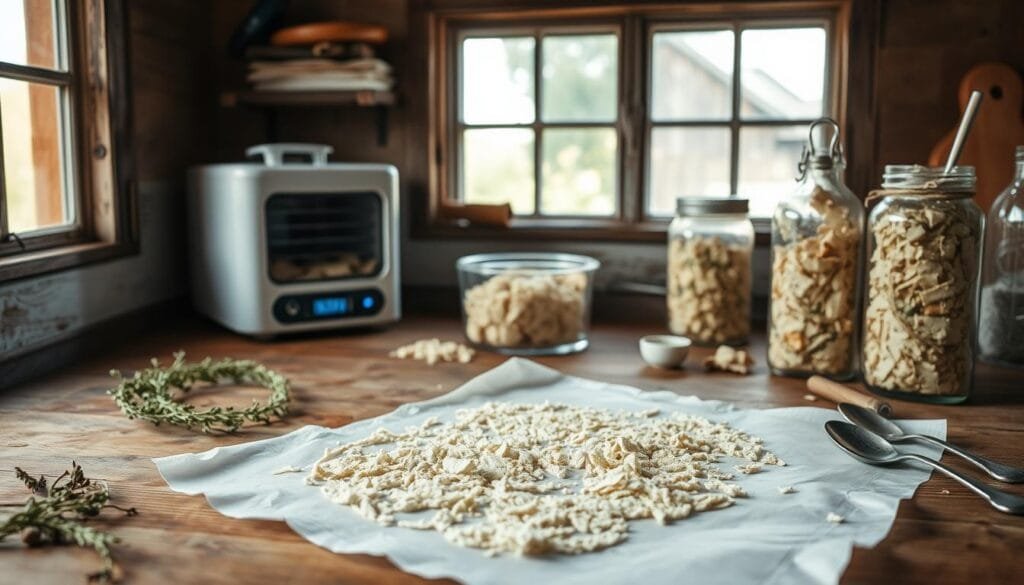Preserving your sourdough starter through dehydration is not only practical but also an amazing way to ensure it’s always ready to use when inspiration strikes. Whether you’re an experienced baker or just getting started, this simple process will help you create a backup that can last for years. Plus, it’s a wonderful way to share your sourdough journey with friends and family.
Why Dehydrate Sourdough Starter?

Dehydrating sourdough starter isn’t just about storage; it’s about safeguarding something you’ve nurtured and grown. This process protects your starter from mold, neglect, or unexpected interruptions in your baking routine. Imagine having your trusty starter ready to revive whenever you need it—it’s a game-changer for busy bakers.
Here’s why dehydrating is a must:
- Longevity: Keeps your starter viable for months, even years, without refrigeration.
- Portability: Perfect for sharing or taking on the go.
- Resilience: Protects against contamination and accidental neglect.
- Convenience: Revives quickly when you’re ready to bake.
When to Dehydrate Your Sourdough Starter

The best time to dehydrate your sourdough starter is when it’s most active and bubbly—typically 4–8 hours after feeding. At this peak, your starter is full of thriving yeast and bacteria, ensuring it’s primed for rehydration later.
Have sourdough discard? You can dry it too! Just keep in mind that it may require a bit of extra care and feeding to regain full strength once revived.

Essential Tools and Materials
You don’t need fancy equipment to dehydrate sourdough starter—just a few basics:
- Non-stick surfaces: Silicone mats, parchment paper, or baking trays.
- Airtight containers: Glass jars, resealable bags, or vacuum-sealed bags.
- Spatula or scraper: For spreading the starter thinly.
Optional tools to make life easier:
- Food dehydrator: Offers consistent drying.
- Fans: Speeds up air drying.
- Grinder: Turns dried starter into fine powder for easy storage.
How to Dehydrate Sourdough Starter

1. Air Drying
Air drying is simple, budget-friendly, and works beautifully. The process typically takes 1–3 days, depending on the humidity and airflow in your kitchen.
- Spread a thin layer of active starter on parchment paper or a silicone mat.
- Leave it in a well-ventilated spot, away from direct sunlight.
- Check it after 1–3 days. Once it’s brittle, break it into flakes.
2. Food Dehydrator
If you have a dehydrator, you’re in for an easy, hands-off process. This method typically takes 6–8 hours.
- Spread the starter on a dehydrator tray lined with parchment paper.
- Set the temperature to 95°F–105°F (35°C–40°C).
- Dry for 6–8 hours or until crisp.
3. Solar Drying
For an eco-friendly option, harness the power of the sun. This method can take 24–48 hours, depending on the weather conditions.
- Spread the starter thinly on parchment paper.
- Place it in direct sunlight and cover it with a breathable mesh to protect it from bugs.
- Dry for 24–48 hours, depending on the weather.
Keep in Mind:
- High humidity can slow the process, so opt for another method if it’s damp.
- Consistent temperatures help preserve the yeast and bacteria.
Ways You Shouldn’t Dehydrate Sourdough Starter

Not all drying methods are created equal. Here’s what to avoid:
1. Oven Drying
- Even at the lowest temperature, ovens can exceed 120°F, killing the yeast and bacteria that make sourdough magic.
- Exception: Some convection ovens have a fan-only setting. If yours does, this can mimic air drying—just ensure the heat is completely off.
2. Microwave Drying
- Microwaves heat unevenly, creating hot spots that can ruin your starter.
- This method is messy, unpredictable, and best avoided.
How to Package and Gift Dehydrated Sourdough Starter
There’s something special about gifting a piece of your sourdough journey. Here’s how to make it memorable:
- Choose Airtight Packaging: Small jars, resealable bags, or vacuum-sealed pouches work great.
- Add Instructions: Include a note with rehydration and feeding steps.
- Personalize It: Tie a ribbon around the jar, write a heartfelt note, or add a recipe for your favorite bread.
- Bundle It Up: Pair with a mini wooden spoon, a bag of flour, or a bread lame for a thoughtful gift set.
Need ideas? Check out my video on how I package and gift my starter: Watch Here.
Sourdough Starter Kits
Starter kits are a fantastic way to simplify your sourdough adventure. They often include tools like jars, scrapers, and helpful instructions. Curious about my favorite kit? I’ve shared my thoughts in this review: Sourdough Kit Review.
Proper Storage for Dried Sourdough Starter
To keep your dehydrated starter fresh and ready to use:
- Store it in a cool, dark place, like a pantry or cupboard.
- Use airtight containers to prevent moisture from creeping in.
- Label with the drying date for easy reference.
Shelf Life by Storage Method:
- Airtight container: Up to 1 year.
- Refrigeration: Up to 6 months.
- Freezing: Up to 1 year.
How to Reactivate Dried Sourdough Starter
If you’re interested in rehydrating your sourdough starter, I’ve created a detailed guide to walk you through the process step by step. You can download it here: Download Now.
Tips for Successful Dehydration and Storage
- Use clean tools and surfaces to avoid contamination.
- Make sure the starter is completely dry before storing.
- Check periodically for signs of moisture or spoilage.
- Keep a small batch of dried starter as a backup—you’ll thank yourself later.
Dehydrating your sourdough starter isn’t just about convenience—it’s about preserving a piece of your baking journey. Whether you’re prepping for long-term storage, gifting to a friend, or just trying something new, this process keeps your sourdough culture alive and well. Happy baking!








